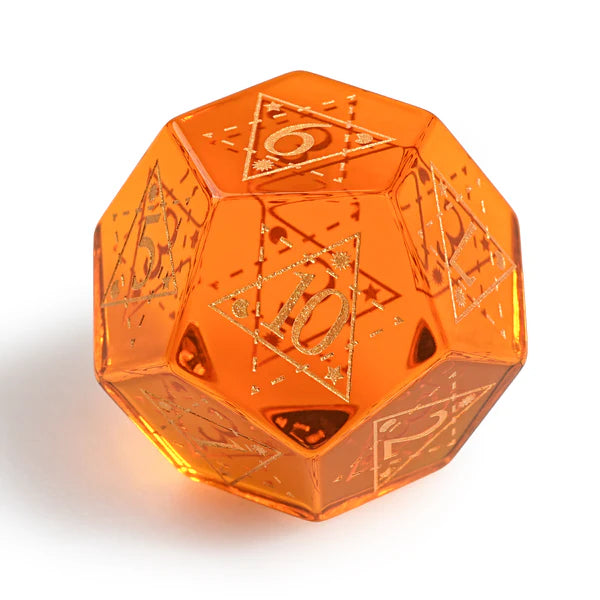In the world of board games, Celadon Resin Dice stands out as a unique blend of art and culture. It perfectly combines the ancient celadon culture with modern resin craftsmanship, opening up a marvelous journey.

Enjoy 30% off all items during Christmas --- CHRISTMAS30
Introduction: The Artistic Transformation Journey of Dice
Nowadays, table game players are no longer limited to practical props, but also pursue artistic aesthetics. Porcelain resin dice are like a stream of fresh air, adding an elegant flavor to table games. It is not just an
ordinary dice, but also a piece of art that can be enjoyed. Its unique design and craftsmanship have triggered people's desire to explore the fusion of tradition and modernity. When porcelain meets resin, what kind of marvelous reaction will occur?

Inspiration: The depth of the art of blue and white porcelain
(I) The Beauty of Classic Patterns
The classic patterns of blue and white porcelain are the inspiration for the dice design. The vines of the entwined lotus pattern stretch sinuously on the surface of the dice, the lotus flower is in full bloom, the petals and leaves sway gently with the wind, and it seems as if you can sense the beautiful rhythm of life when you turn the dice. In the dragon and phoenix pattern, the dragon's robustness and the magnificence of the phoenix are fully displayed, with their lifelike postures, detailed scales and feathers, adding a mysterious and solemn feeling to the dice.

(ii) Concentration of landscape mood
The plum blossom pattern on the dice is amazing. Despite the limited space, the designer has skillfully condensed the rolling hills, misty clouds, rushing rivers and sailing boats into one side. When players gaze at it, they seem to be in a grand natural environment through the small window, their hearts are comforted and their thoughts drift to faraway places, which greatly touches their emotions and imagination.
Artistic presentation: a double feast of dice vision and culture
(I) The charm of blue and white intertwining
The blue and white color scheme is its visual highlight. The blue cyanotype pigments are as varied as the sky, contrasting with the pure white resin base color to create a simple and elegant effect. Under the light, the blue and white patterns change, revealing their dynamic beauty.
(ii) The delicacy of microscopic strokes
The pattern is extremely delicate. The texture of the stamens, the folds of the petals, and the feathers of the animal hair are all accurately portrayed. In the case of the peony, for example, the petals are layered and the veins are clearly visible, and it seems that the softness and tenderness of the petals can be felt, as if they are actually blooming in front of the eyes. This demonstrates the skill of the craftsmen, making the dice a miniature work of art.
(III) Inheritance of Cultural Symbols
Dice patterns are rich in cultural symbols. The entwined lotus pattern symbolizes the beauty and auspiciousness of life, and the dragon and phoenix represent the harmony of will. The integration of these cultural symbols adds cultural connotation to the table game. When players roll the dice, they inadvertently convey good wishes, making the game a cultural heritage journey.
Craftsmanship: the mastery and persistence behind the craftsmanship
(I) Wisdom of Resin Selection
High-quality resin is crucial when making the game. With its high transparency, it can clearly show the details of the celadon pattern, just like enjoying a painting through glass. It is highly malleable and can be molded into the shape of a dice and perfectly combined with the pattern. Good stability, not affected by the environment, to ensure that the quality and appearance of the dice is long-lasting.
(ii) Control of process details
When processing the material, the resin mixing ratio, mixing speed and temperature need to be strictly controlled. The slightest deviation may lead to bubbles, cracks and other defects during the casting and curing process, destroying the aesthetics and quality of the dice. With experience and dedication, the craftsmen carefully operate each step to ensure uniform and stable molding of the resin.
(III) The ingenuity of pattern embedding
Embedding patterns is extremely challenging. The celadon pattern is first printed with high precision on film or paper, then precisely placed in the mold and poured into the resin. During the curing process, the pattern and the resin are tightly connected. Craftsmen need to be experienced and skillful to ensure that the pattern is precisely positioned without distortion or blurring.
(D) Craftsmanship in polishing
After the dice have been molded, they undergo a number of manual sanding and polishing processes. First, coarse sandpaper is used to remove burrs, then fine sandpaper is used to make the surface smooth, and finally the dice are polished to a bright luster. These manual operations enhance the appearance of texture, but also convey the craftsman's heart and warmth.
Conclusion: Dice value sublimation and cultural promotion
Celadon
resin dice have a unique value in the field of table games and collections. It brings a new visual experience and cultural heritage in board games, and is a precious artwork in collection, with its cultural value becoming more and more prominent with time. It is a cultural carrier, connecting the ancient and the modern. May more people love this unique dice set, feel the charm of its fusion, promote the dissemination and exchange of traditional culture in the modern society, let the ancient art blossom in the new era, and inherit the millennium culture and skills.






Leave a comment
This site is protected by hCaptcha and the hCaptcha Privacy Policy and Terms of Service apply.